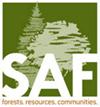Management of Mixed-Species, Uneven-Aged Forests in the French Jura: From Stochastic Growth and Price Models to Decision Tables
IF 1.5
4区 农林科学
Q2 FORESTRY
引用次数: 0
Abstract
A deterministic matrix growth model of uneven-aged stands of fir, spruce, and hardwood trees was extended to recognize random shocks. The results showed that the expected basal area of hardwoods, mainly beech, was substantially higher in the long run than that predicted by the deterministic model. A parallel stochastic model of prices was also developed from past data. It showed that real prices had no trend but that they were autocorrelated over time. The stochastic stand and price models were simulated simultaneously to obtain the probabilities of transition between stand and market states. This transition probability matrix was used in Markov decision-process models to calculate the best decision in each possible stand and market state. The policies examined included maximizing net present value, or expected tree diversity, production, or annual returns, subject to constraints on net present value, expected tree diversity, and basal area. A general mathematical programming method is presented to optimize economic or ecological objective functions subject to multiple constraints with or without time discounting. In the French Jura context, the solutions suggested that high net present value could be obtained while maintaining the average basal area near its current level, and keeping a high level of tree diversity. Accounting for risk called for more intense harvesting to raise revenues, and it led to stands that were much more diverse than suggested by deterministic solutions. FOR. SCI. 51(1):64–75.法国汝拉地区树龄不均的混交林管理:从随机增长和价格模型到决策表
对冷杉、云杉和硬木等不均匀树龄林分的确定性矩阵生长模型进行了扩展,以识别随机冲击。结果表明,硬木(主要是山毛榉)的预期基部面积在长期内大大高于确定性模型的预测值。还根据过去的数据建立了一个平行的价格随机模型。结果表明,实际价格没有趋势,但随着时间的推移自相关。同时模拟随机林分和价格模型,以获得林分和市场状态之间的过渡概率。这种过渡概率矩阵被用于马尔可夫决策过程模型,以计算在每种可能的林地和市场状态下的最佳决策。所研究的政策包括净现值最大化、预期树木多样性最大化、产量最大化或年收益最大化,但受净现值、预期树木多样性和基部面积的限制。本文介绍了一种通用的数学编程方法,用于在有或没有时间贴现的多重约束条件下优化经济或生态目标函数。在法国汝拉地区,解决方案表明,在将平均基部面积保持在当前水平附近并保持较高树木多样性的同时,可以获得较高的净现值。考虑到风险,就需要加大采伐力度以增加收入,这也导致林分的多样性远高于确定性解决方案所建议的多样性。FOR.SCI.51(1):64-75.
本文章由计算机程序翻译,如有差异,请以英文原文为准。
求助全文
约1分钟内获得全文
求助全文
来源期刊

Forest Science
农林科学-林学
CiteScore
2.80
自引率
7.10%
发文量
45
审稿时长
3 months
期刊介绍:
Forest Science is a peer-reviewed journal publishing fundamental and applied research that explores all aspects of natural and social sciences as they apply to the function and management of the forested ecosystems of the world. Topics include silviculture, forest management, biometrics, economics, entomology & pathology, fire & fuels management, forest ecology, genetics & tree improvement, geospatial technologies, harvesting & utilization, landscape ecology, operations research, forest policy, physiology, recreation, social sciences, soils & hydrology, and wildlife management.
Forest Science is published bimonthly in February, April, June, August, October, and December.
 求助内容:
求助内容: 应助结果提醒方式:
应助结果提醒方式:


